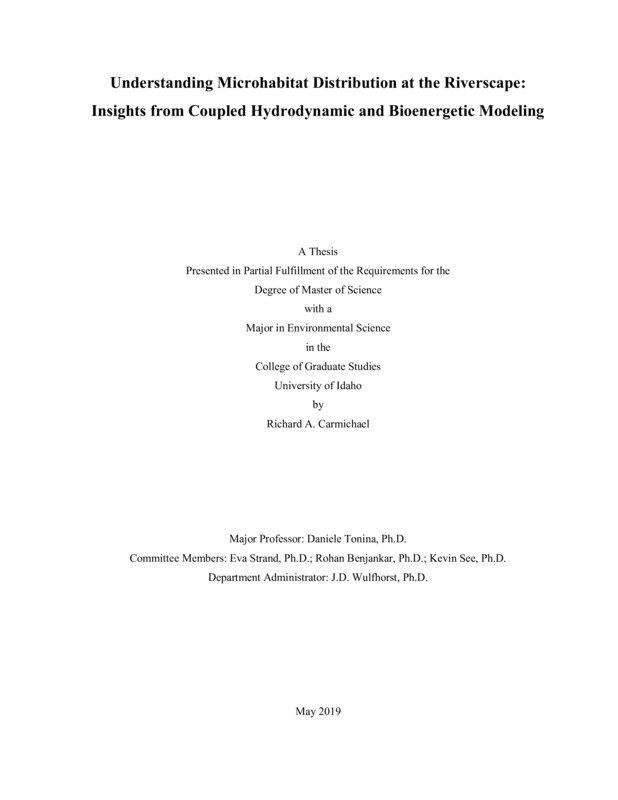Understanding Microhabitat Distribution at the Riverscape: Insights from Coupled Hydrodynamic and Bioenergetic Modeling
Carmichael, Richard Anthony. (2019-05). Understanding Microhabitat Distribution at the Riverscape: Insights from Coupled Hydrodynamic and Bioenergetic Modeling. Theses and Dissertations Collection, University of Idaho Library Digital Collections. https://www.lib.uidaho.edu/digital/etd/items/carmichael_idaho_0089n_11523.html
- Title:
- Understanding Microhabitat Distribution at the Riverscape: Insights from Coupled Hydrodynamic and Bioenergetic Modeling
- Author:
- Carmichael, Richard Anthony
- ORCID:
- 0000-0002-5230-1003
- Date:
- 2019-05
- Keywords:
- Bioenergetics Fisheries Flow Modeling LiDAR Remote Sensing
- Program:
- Environmental Science
- Subject Category:
- Civil engineering; Environmental science; Remote sensing
- Abstract:
-
Understanding and evaluating complex links between anthropogenic and natural processes has become an essential piece in freshwater conservation and management. Characterization and monitoring of streams worldwide has been difficult due to the complex nature of river systems and the organisms that inhabitant them. With recent advances in technology and modeling techniques, the scientific community has begun to improve characterization of processes governing freshwater streams and rivers. To further understanding and management of river systems, we present novel technological and modeling techniques to gain insights into said links and provide guidance related to freshwater and fisheries management where we apply these methods to the Lemhi River of Eastern Idaho. First, we processed and validated a new generation bathymetric light detection and ranging system known as the Experimental Advanced Airborne Research LiDAR-B (EAARL-B). This newly developed aerial system relies on the travel time of light energy pules to measure distance from the sensor which generates high resolution mapping (~1 point/m2) of stream corridors, including the bathymetry, banks, and floodplains at watershed scales (100 km). Next, we used a validated, bare earth filtered, digital surface model supported by the EAARL-B system to develop a series of numerical flow models for the assessment of aquatic habitat as it relates to endangered Chinook salmon. Leveraging the spatially continuous modeled depth and velocities, we coupled flow hydraulics with publicly available empirical data including: Lemhi River Chinook salmon length and mass distributions, drifting macroinvertebrate rates, measured stream temperature, and representative measured discharges to develop a bioenergetics model to assess the impacts of water diversion, stream flow, morphological channel simplification, and stream temperature on juvenile Chinook salmon habitat suitability of the mainstem Lemhi River. We compared three distinct 1 km reaches with variable morphological complexity, a single thread confined channel, a multithread complex reach, and an engineered restoration reach to model juvenile Chinook salmon bioenergetic profitability for two critical time periods, late summer low flow (August) and late fall, fully undiverted, natural flow regime (October). We conclude that morphological complexity, specifically side and off-channel habitat, is essential for supporting juvenile Chinook salmon growth. As temperature begins to decrease in the fall, and mainstem discharges are increased due to water management, the morphologically complex reach provided the greatest amount of suitable habitat to sustain or promote growth for juvenile Chinook salmon.
- Description:
- masters, M.S., Environmental Science -- University of Idaho - College of Graduate Studies, 2019-05
- Major Professor:
- Tonina, Daniele
- Committee:
- Benjankar, Rohan; Strand, Eva; See, Kevin
- Defense Date:
- 2019-05
- Identifier:
- Carmichael_idaho_0089N_11523
- Type:
- Text
- Format Original:
- Format:
- application/pdf
- Rights:
- In Copyright - Educational Use Permitted. For more information, please contact University of Idaho Library Special Collections and Archives Department at libspec@uidaho.edu.
- Standardized Rights:
- http://rightsstatements.org/vocab/InC-EDU/1.0/

